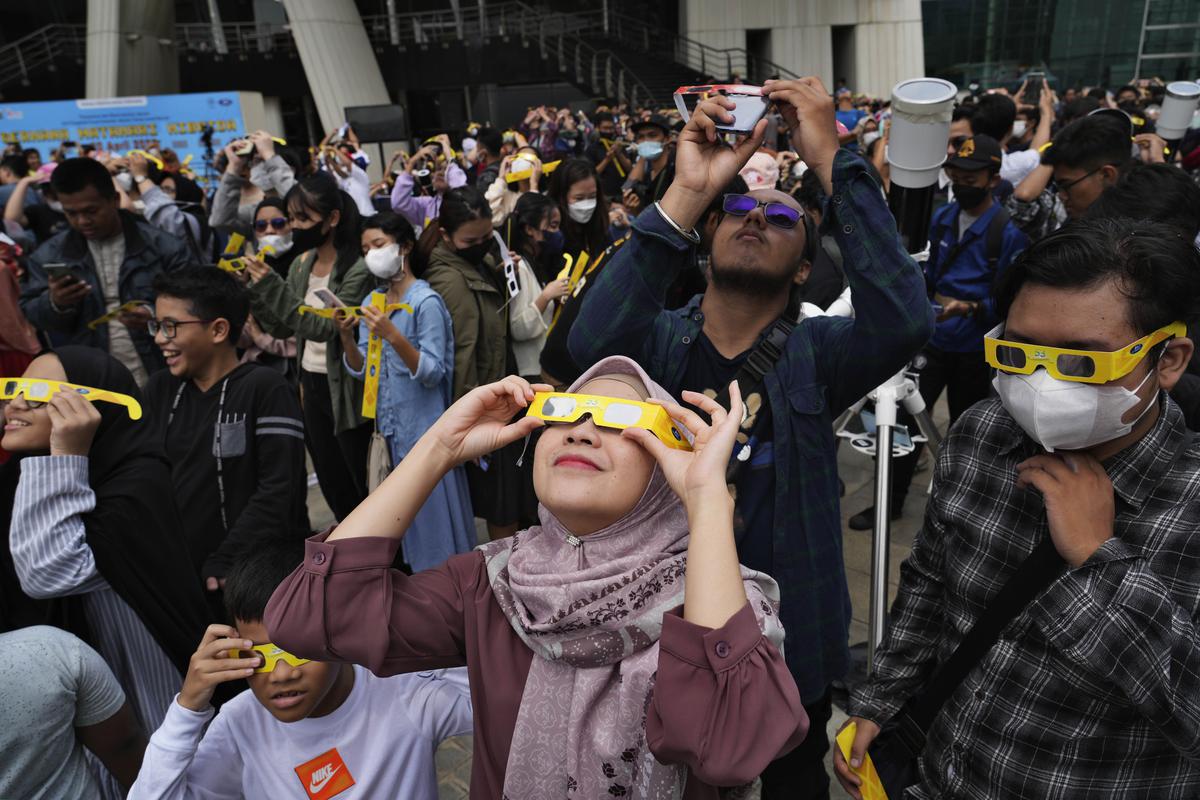
A hybrid solar eclipse as seen with the use of a solar filter at the Great Mosque area in Padang, West Sumatra Province, Indonesia on April 20, 2023. , Photo Credit: Reuters
About 20,000 eclipse chasers gathered under a cloudless sky in the northwestern Australian coastal town of Exmouth to enjoy a rare total solar eclipse that plunged the region into darkness for about a minute on Thursday morning.
The remote tourist town with fewer than 3,000 residents was promoted as one of the best vantage points in Australia to view the eclipse that also crosses remote parts of Indonesia and East Timor.
An international crowd had been gathering in Exmouth for days, camping in tents and trailers in a red, dusty field on the edge of town with cameras and other viewing equipment pointed skyward.
In the Indonesian capital, hundreds of people flocked to the Jakarta Planetarium to watch the partial eclipse, which was covered by clouds.

People use protective glasses to watch a solar eclipse on April 20, 2023 in Jakarta, Indonesia. A rare solar eclipse will pass through remote parts of Australia, Indonesia and East Timor on Thursday. , Photo Credit: AP
Azka Azzahra, 21, came with her sister and friends along with hundreds of other visitors to take a closer look using binoculars.
“I am still happy to be here even though it is cloudy. It is heartening to see the enthusiasm with which people come here to watch the eclipse as it happens very rarely,” said Ms. Azzahra.
When the period of eclipse started, the sound of Azaan started echoing from the mosques of the city and the Muslims told the prayer of eclipse as a reminder of the greatness of God.
NASA astronomer Henry Tropp was among those in Exmouth loudly cheering the eclipse in the dark.
“Stunning isn’t it? It’s pretty spectacular. It was mind-blowing. It was so fast and it was so bright. You could see the corona around the sun there,” the Washington resident enthused told the Australian Broadcasting Corp.
“It’s only a minute long, but it seemed like a really long time. There’s nothing else you can see. It was awesome. Visible. And then you could see Jupiter and Mercury And could see them at the same time during the day – it’s very rare to even see Mercury. So it was pretty spectacular,” Mr Throop added.
The hybrid solar eclipse was visible from the Indian Ocean to the Pacific Ocean and was mostly over water.
Some lucky people along its path saw either the darkness of a total eclipse or a “ring of fire” as the Sun peeked out from behind the new moon.
Such astronomical events happen once every decade: the last one was in 2013 and the next one won’t happen until 2031.
They occur when Earth is in the “sweet spot,” so the new moon and the sun are roughly the same size in the sky, said Michael Kirk, NASA solar expert.
At some points, the Moon is slightly closer and blocks out the Sun in a total eclipse. But when the Moon is a little further away, it lets some of the Sun’s light through in an annular eclipse.
“It’s a crazy event,” Mr Kirk said. “You are actually seeing the moon getting bigger in the sky.”
Many other upcoming solar eclipses will be easy to catch. Both the annular eclipse in mid-October and the total eclipse next April will cross millions of people in the US.